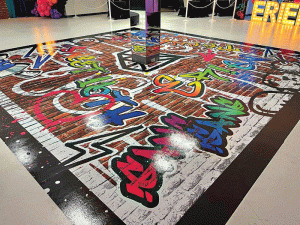
For vinyl floor graphics, it is important to understand the surfaces they will be installed on, how long they are going to be down, and what kind of traffic they will see.
Make good choices
Everyone is looking for a simple, one-size-fits-all solution which will stick to everything, stay up indefinitely, and come down cleanly when the time is right—regardless of the surface it is sticking to, or how long it has been up. The best I have seen is a one-size-fits-most, which still involves a lot of luck and careful material selection.
There is much that can be done with material selection on the front end, before ink hits vinyl, to ensure a job well done. The best way to foster those good choices is to ask good questions. It is important to understand some of the basic elements of the intended surface you are sticking to, as well as how you want the adhesives to perform.
Two key factors to consider from the outset are not all adhesives are equal, and “removable” is not a universal term. Just as there are different paints for different surfaces—matching the level of bond, durability, and performance of the project—the same is true of adhesive vinyl.
Using a low-tack removable window film on high-gloss painted walls might work, but the performance is not guaranteed, and there are engineered solutions which might be more suitable.
The key with vinyl graphics is to match the material with the application.
A quick look at the building blocks of adhesive vinyl products will help develop an understanding of which product is best suited for which project. Stickers and decals have three basic components: film, adhesive, and liner. The film is normally polyvinyl chloride (PVC) and is available either calendered or cast, with monomeric or polymeric film. “Cast” and “calendered” reference the manufacturing method, while “monomeric” and “polymeric” reference the ingredients.
Most everyday, three- to five-year outdoor films are in the polymeric calendered category. Wall films, floor graphics, and other specialty materials also fit in this category. High-performance, high-cost, long-term options are in the polymeric cast vinyl category, and short-term, economic options are in the monomeric calendered category.
Adhesives have a wide range of options, with key terms like “permanent” and “removable,” “solvent” and “water-based,” “high-tack” and “low-tack,” and “opaque” and “clear.” The intended applications for these different chemistries are typically mentioned on the manufacturer’s data sheets, and it is highly recommended to consult these documents to help build material knowledge. A good distributor partner or manufacturer’s representative will also be a helpful resource when processing the information for different applications.





